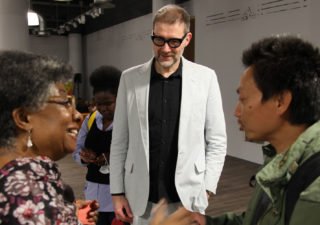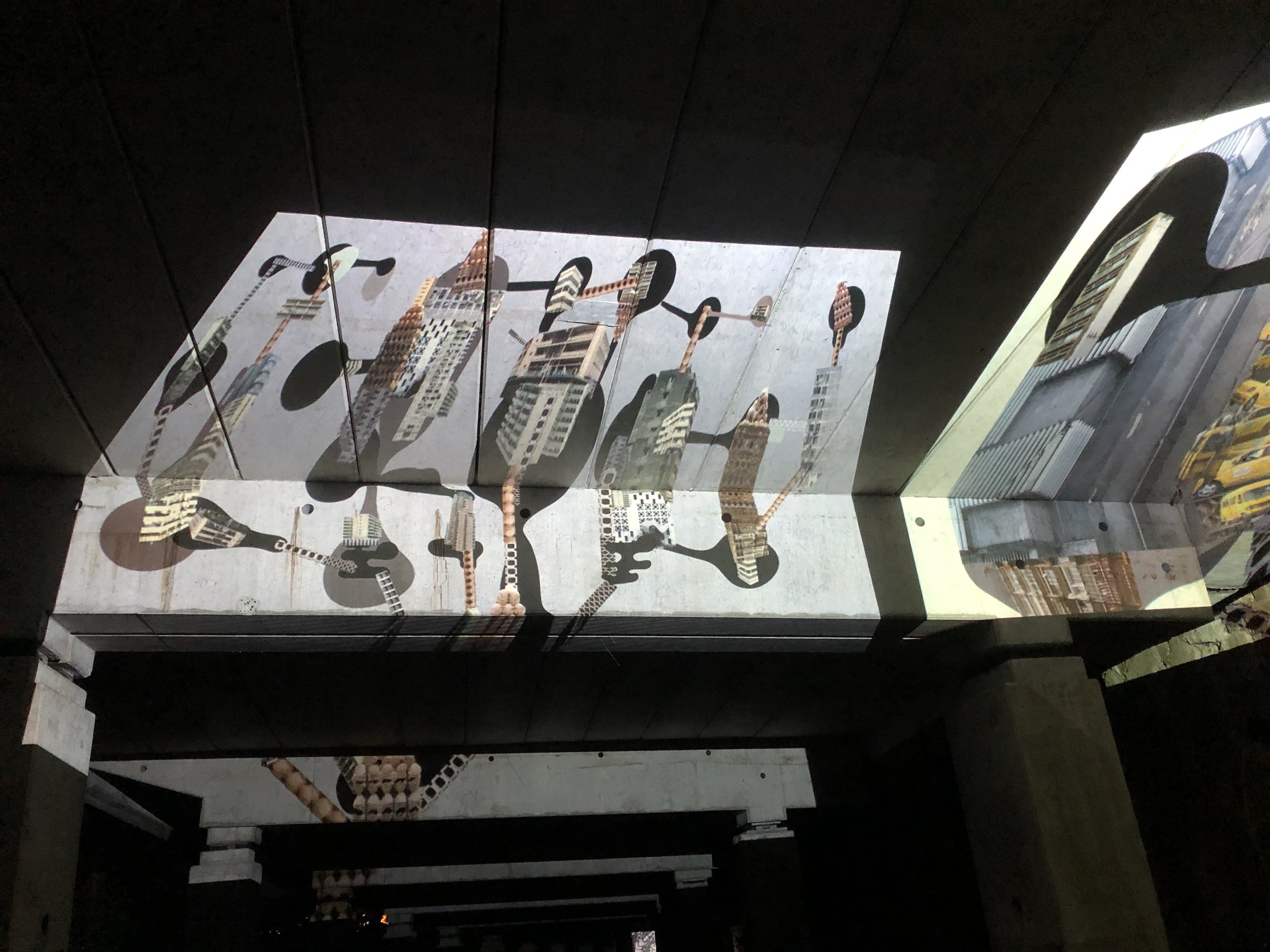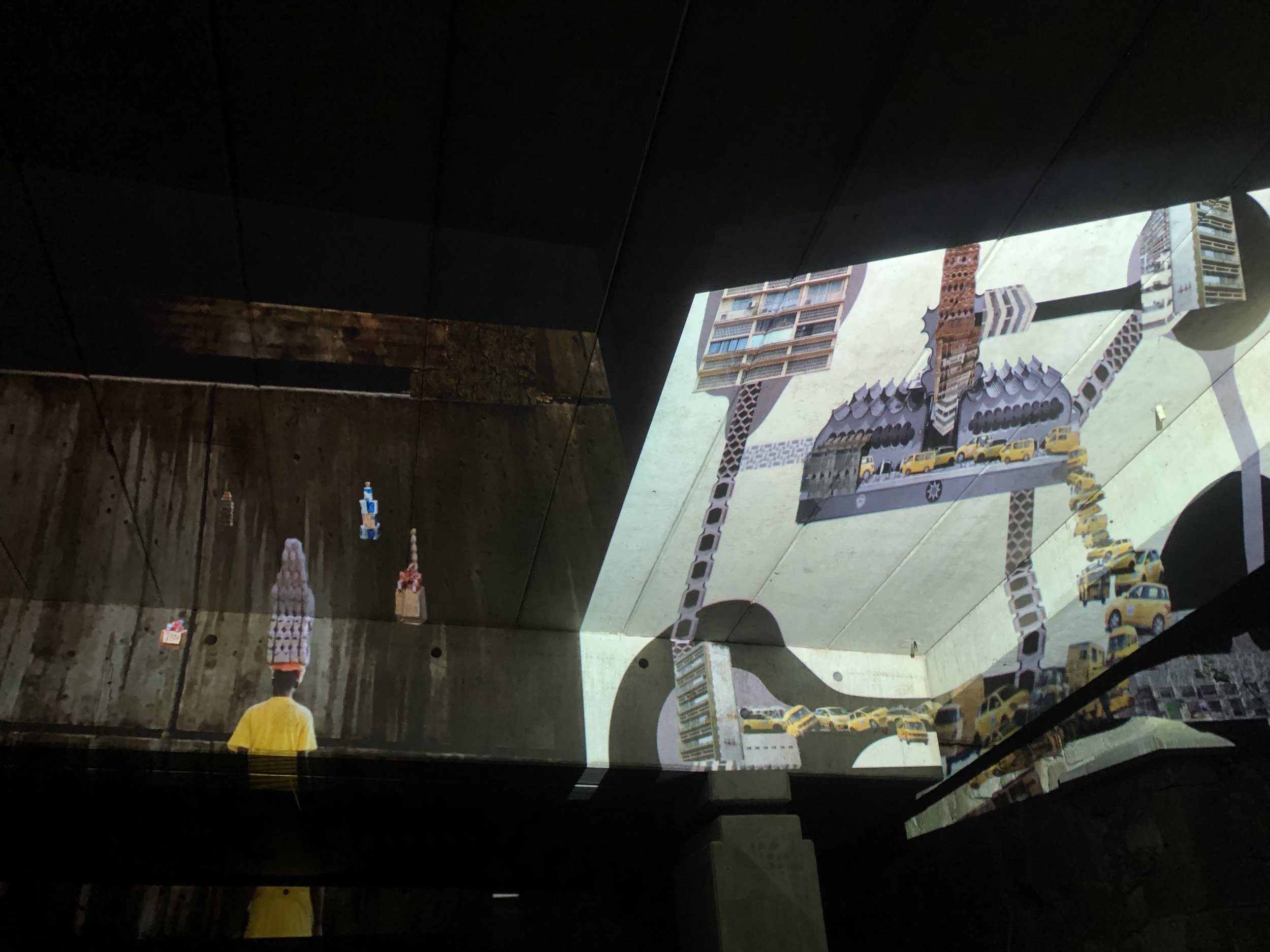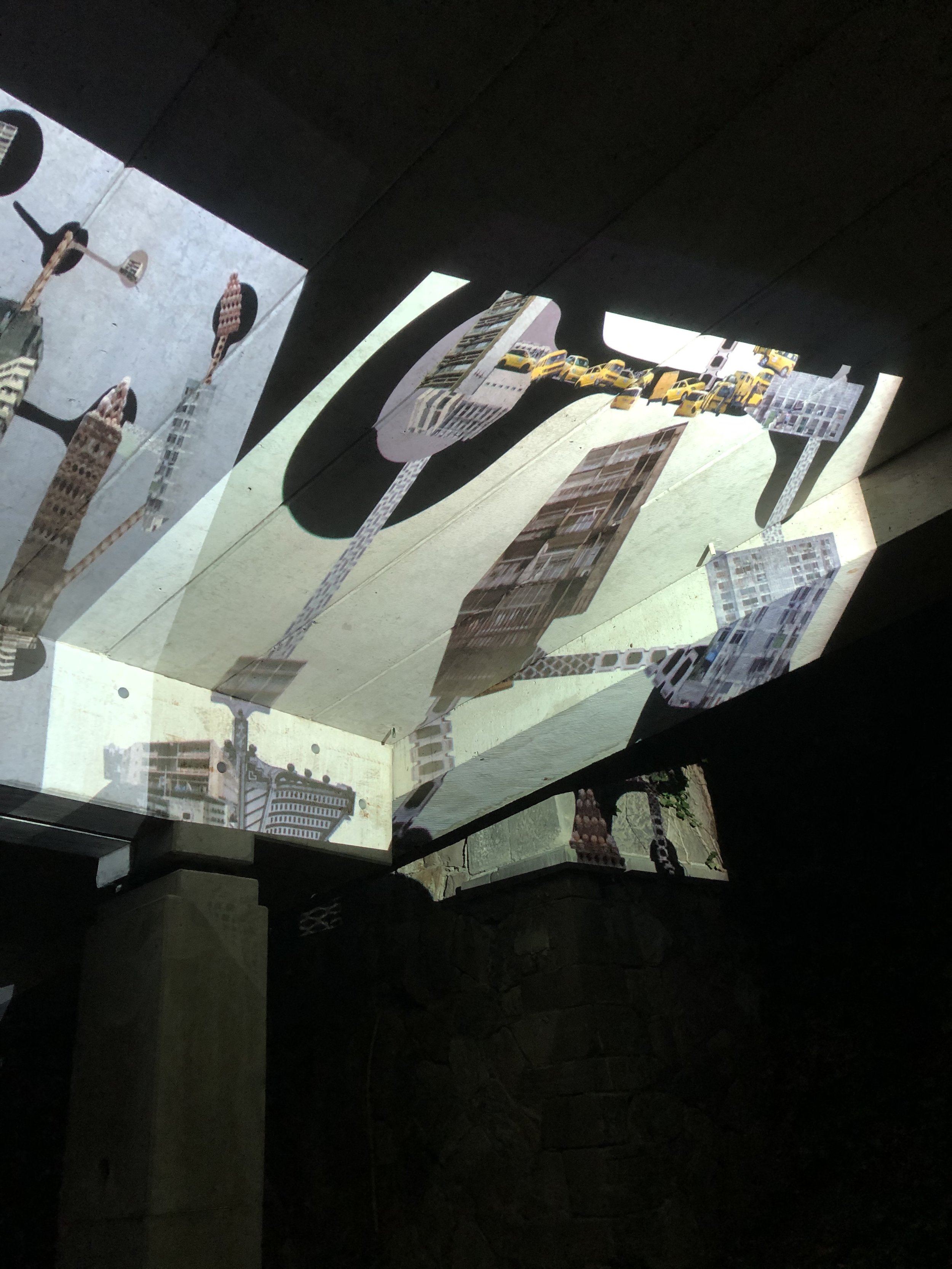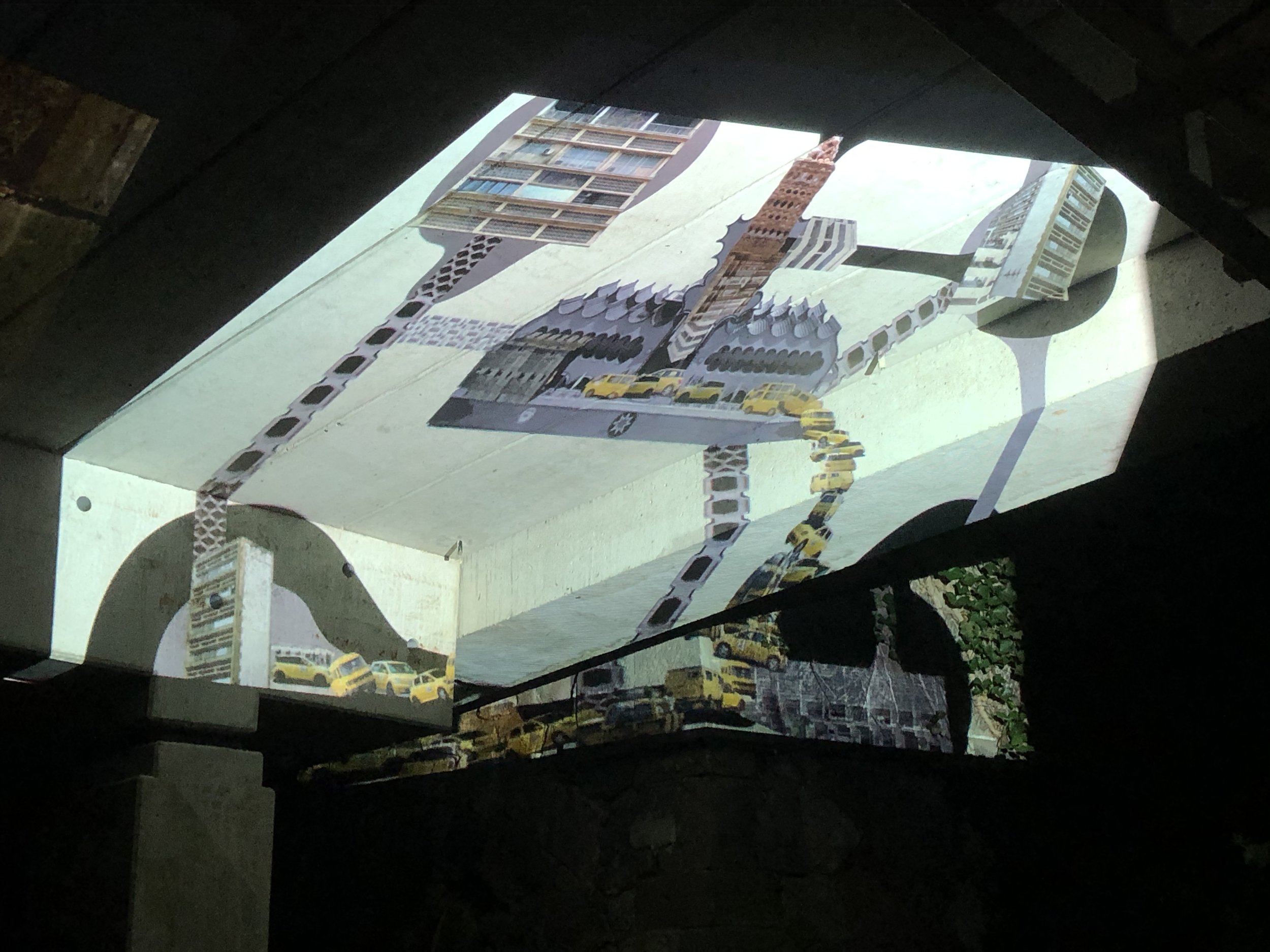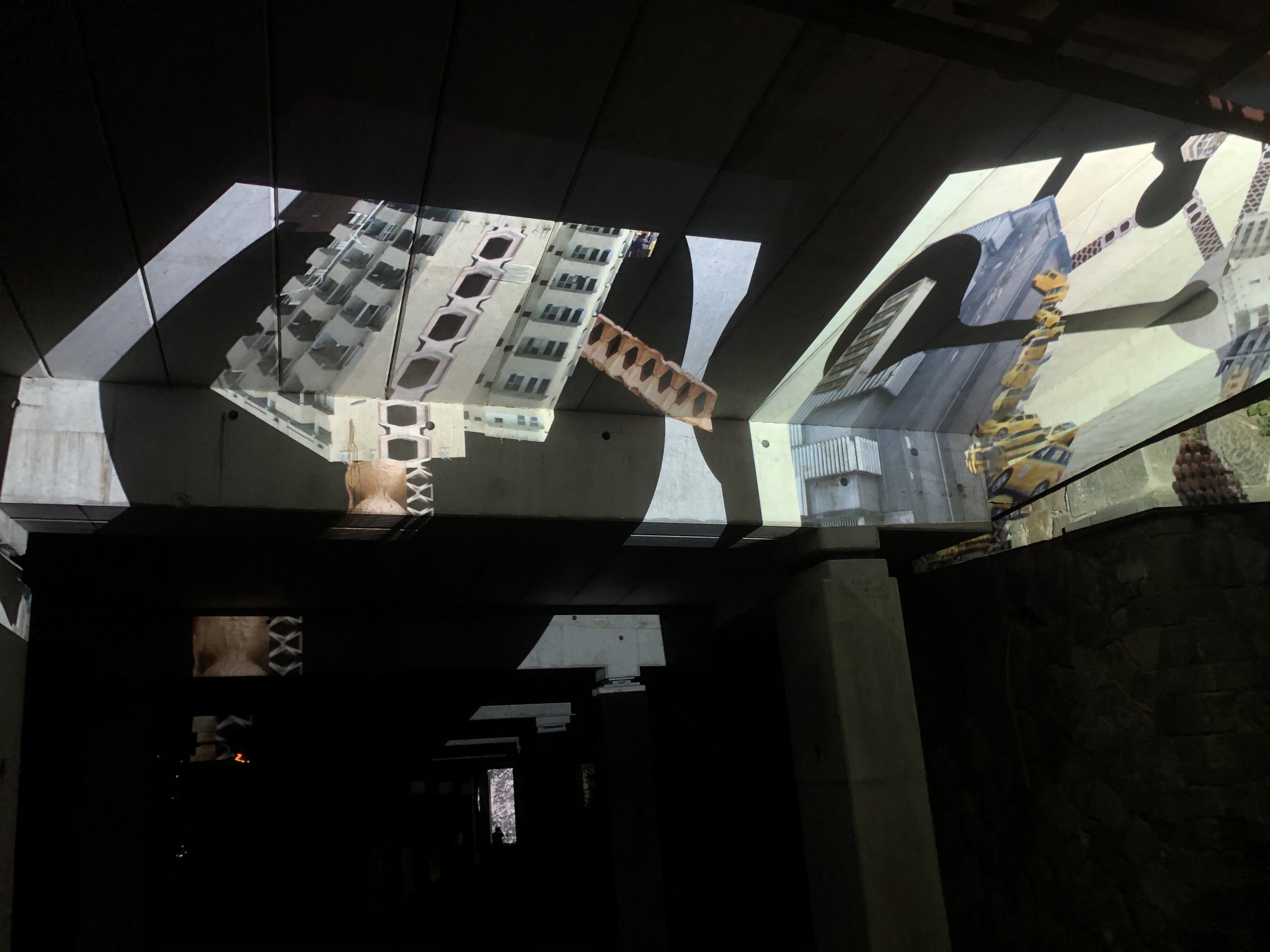Blind Spots in the Sun at ruruhaus (documenta fifteen) & art in public space
As part of an event held by Blind Spots in the Sun at ruruhaus/documenta fifteen during KW35 (Kassel Museum Week) Henrik Langsdorf’s video installation “Rudolf Duala Manga Bell — a German Story” was shown for the first time. It was again on view at ruruhaus as part of the International Weeks against Racism in March 2022 and was shown at MARKK Museum in Hamburg, Germany.
As part of an event held by Blind Spots in the Sun at ruruhaus (documenta fifteen) during KW35 (Kassel Museum Week) Henrik Langsdorf’s video installation “Rudolf Duala Manga Bell — a German Story” was shown for the first time. It was again on view at ruruhaus as part of the International Weeks against Racism in March 2022 and was shown at MARKK Museum in Hamburg, Germany.
“Burning Village”, a scene from “Rudolf Duala Manga Bell – a German Story”, 2021-22
Princess Marilyn Douala Manga Bell with Henrik Langsdorf and Reza Afisina of ruangrupa (curators of documenta fifteen)
The video presentation was preceded by a panel discussion on the correlation between the German colonial history and anti-Black racism in Germany today — the core issues at the heart of Blind Spots in the Sun, an initiative that deals with these questions through a series of art interventions.
“Rudolf Duala Manga Bell — a German Story” tells the story of a Cameroonian king who was executed by the German colonial government for his resistance against German plans to establish an apartheid system in his hometown Douala.
What makes his case unique is that he fought the German Empire on its own turf, using the principles of rule of law against his oppressor: he repeatedly submitted petitions to the German parliament, sent telegrams to the Reich’s chancellor and even got the press involved to sway public opinion to make his case.
The interwoven narratives between German and Cameroonian interests go back at least two generations, when Duala Manga Bell’s grandfather King Bell, who was one of several leaders from Duala (Cameroon), signed a ‘protection treaty’ with German merchants in 1884. This led to Cameroon becoming a German colony. On the outset the Duala leaders, who had been engaging in international trade for generations, were seeking to formalize relations with German merchants in the hope of a mutually beneficial relationship with Germany.
As part of the effort the Bell family sent their scion Rudolf to Germany, where he received a warm welcome. Studying classics of German literature, he became an admirer of German culture and developed a keen interest in the legal system as an aspiring law student.
“Being German” A scene from “Rudolf Duala Manga Bell – a German Story”, 2021-22
While looking at Duala Manga Bell’s quest to become a model citizen of the German Empire — he was said to have perfected his command of the language as well as his manners and was highly respected among colonial officials — and the ensuing battle that frustrated all his aspirations, the video installation ties this piece of shared history to the present by inserting images of contemporary Germans of all skin colors, uttering the word “deutschsein” (being German) or reading poetry by the Afro-German writer May Ayim, thus raising questions of cultural identity in Germany today.
Though Langsdorf approaches these issues in the form of artistic examination, the piece does not shy away from delivering historic information, which has led to inquiries from schools and academics to use this work as teaching material.
For the research on this project, Langsdorf collaborated with Princess Marilyn Douala Manga Bell, great-granddaughter of Duala Manga Bell as well as his great-nephew Jean-Pierre Félix Eyoum.
From left to right: Emilene Wopana Mudimu, Henrik Langsdorf, Aisha Camara, Princess Marilyn Douala Manga Bell,
Jean-Pierre Félix Eyoum
Prior to the presentation of the video installation, Princess Douala Manga Bell gave a personal introduction of her ancestor during the opening remarks of the panel discussion that took place that evening at ruruhaus in cooperation with the Heinrich Böll Foundation Hessen.
The panel included filmmaker Mo Asumang, who received the Order of Merit of the Federal Republic of Germany for her anti-racism work, Princess Marilyn Douala Manga Bell, who is a social economist, curator and co-founder of doual’art in Duala, Cameroon, and who received the 2021 Medal of Honor of the Federal Republic of Germany from the Goethe-Institut, Emilene Wopana Mudimu, who is a social worker, poetry artist and activist in the fields of empowerment work with black people and anti-racism training, Jean-Pierre Félix-Eyoum, who worked as a special education teacher and is a co-founder of Deutschland Postkolonial, and Henrik Langsdorf.
Blind Spots in the Street
Blind Spots in the Sun began in spring 2021 with an open call for a public art project in which artists, illustrators, designers and photographers from the former German colonies in Africa as well as Afro-German artists were invited to express their views on how the German colonial history and/or anti-Black racism in Germany has affected their lives.
In August, the winning entries as well as the results of the project “What we don’t see in Kassel” were put up on billboards in various places around the city center.
The initiative was launched in Kassel, the town of 200,000 in Germany that spawned documenta and that sees itself as a haven of culture and open-mindedness. Yet it was also in Kassel, were racist murders took place and where a monument created by Olu Oguibe for documenta 14 had to be moved from one of the central squares in the heart of Kassel to another location, bowing to pressure from the extreme-right party AFD.
The name Blind Spots in the Sun is derived from the phrase “We, too, claim our place in the sun,” which German Foreign Minister Bernhard von Bülow used in 1897 to describe the colonial policy of the German Empire. It also alludes to the many blind spots that exist in the German collective consciousness vis a vis this chapter of its history, and how it helped to embed a more subtle form of racism in the German psyche that remains virulent today.
Racism is often equated with right-wing extremism. This assumption presents a convenient way of eschewing responsibility while it stands in the way of a deeper and more nuanced analysis of the issue.
The vast majority of Germans, though avowed non-racists by self-definition, are not aware that the seemingly harmless act of stereotyping is already a form of racism that can be hurtful and lead to real disadvantages. The effects are othering and micro-aggressions. The fact that in most cases these smaller acts of racism are unintended does not diminish their impact on the psyche of many Afro-Germans.
By exposing these blind spots, this Kassel initiative seeks to disrupt and spark the discourse, and to contribute to a broader definition of racism. The ultimate goal is that the white majority in Germany recognizes its own stake in the issue. A first step is educating ourselves, followed by taking more responsibility and by critically reflecting our own behavior.
“Ville Fantôme: From Utopia To The Present” at the Congo Biennale
Ville Fantôme and Vertical City, 2019. Two-channel video installation at the Congo Biennale. Photo ©Henrik Langsdorf
Henrik Langsdorf: “Ville Fantôme/Kinshasa La Belle”, 2019
In this multi-channel video installation the utopian architectural vision of Congolese artist Bodys Isek Kingelez (1948–2015) meets with Henrik Langsdorf’s visual reflections on urbanism in present-day Kinshasa in the form of animation and collage.
Kingelez, who remains largely unknown in the Democratic Republic of the Congo despite international acclaim, became known for his “extrème maquettes”, extremely colorful architectural models that promise a bright future not only for Kinshasa and other places in his native country, but the world at large.
What if some of his structures had actually been built? How might this wildly beautiful wonderland where “delinquents, police and prisons do not exist” — as Kingelez proposed in an artist statement about his “Projet pour le Kinshasa du Troisième Millénaire”, — have fared two decades into this Third Millennium?” These are the questions Langsdorf explores in “Ville Fantôme/Kinshasa La Belle”.
Bodys Isek Kingelez: Ville Fantôme, 1996. Photo ©Henrik Langsdorf
Henrik Langsdorf: “Ville Fantôme/Kinshasa La Belle”, 2019
Chika Okeke-Agulu, Princeton University art historian and critic, described Kingelez’ cityscapes as “spectacular architectural form as a counter-narrative to the dystopian realities of Kinshasa”. Langsdorf ventures to reconnect them with these realities.
By stripping the buildings of their exuberant hues, and exposing them to imagined aging and decay, he adapts them to the largely monochromatic aesthetic of his own “metabolist collages”, which feature grimy brutalist buildings of the kind found in present-day Kinshasa.
“I have always been fascinated by utopian ideas in architecture, and seeing Kingelez’ retrospective at the MoMA in New York in 2018 was extremely exhilarating and touching. But I’m equally drawn to the urban decay and bleakness that grand architectural dreams often leave in their wake, and how people in an urban context deal with them”, says Langsdorf, “which compelled me to make these videos.”
“Ville Fantôme/Kinshasa La Belle”, a nine-minute animated video, opens with a black and white view of Kingelez’ “Ville Fantôme”. The only person populating the vast boulevards is a street vendor who balances a stack of egg cartons on his head. As the camera zooms in, a tree-like city emerges from the egg cartons.
“Ville Fantôme/Kinshasa La Belle” and “Vertical City” at Light Installations at the Weinberg, Kassel (Germany), 2021
Henrik Langsdorf: “Ville Fantôme/Kinshasa La Belle” II, 2019
In the second part of the video entitled “Kinshasa La Belle”, Langsdorf invokes aerial footage of cities destroyed during World War II as a way of confronting these unabashedly cheerful cityscapes with the grim history of the Democratic Republic of the Congo, which has endured a war that claimed over 5 million lives and has been largely ignored by the Western world. In the ensuing scene that shows a collage of rapidly growing abstract shapes combined with actual Kinshasa buildings, he comments on the uncontrolled growth that this city of over 17 million has been experiencing for the last few decades.
The videos are accompanied by a sound mesh of Kinshasa street noise.
“Vertical City”, a two-minute animated loop, features some of Kingelez’ buildings woven into a proliferation of plant-like shapes that, instead of buds and blossoms, bear morsels of existing Kinshasa architecture and play off the notion that dwellings are like living organisms and units are cells, as envisioned by the metabolist architecture movement in Japan in the 1950s and 60s.
In the resulting thicket Langsdorf pays tribute to the people of Kinshasa, who pulse through the ever-congested arteries of this city in packed taxi buses and yellow cabs.
To emphasize the idea of uncontrolled growth, Langsdorf insists that this video is projected onto multiple surfaces, “to create a sense of distortion and fluidity”, as was the case when the work was presented at the Congo Biennale in 2019 and at “Light Installations at the Weinberg” in Kassel, Germany in 2021, where it was projected onto the concrete pillars of a street overpass.
Henrik Langsdorf: “Vertical City”, animated collage. 2019
It is this Congolese ingenuity — the exalted yet controlled grandiosity of Kingelez’ vision and the humble improvisation of the daily struggle of the people of Kinshasa — that Langsdorf seeks to both celebrate and refract through the prism of his dystopian lens.
Mural for Ken Allen Studios
Mural for Ken Allen Studios. Dye sublimation print on aluminum.
11 Murals for Low-Income Housing Retirement Home (Albany, NY)
Eleven Murals for Royce-on-the-park, Albany, NY
Curated by Marius Muresanu, this series was commissioned by a New York-based developer who specializes in low-income housing. The project was part of a redevelopment of a bleak 1960s retirement home with the objective of engaging residents with immersive wall art as they exit the elevator landing on each residential floor, thus leaving a positive imprint on their daily lives. Henrik Langsdorf was present during the installation and, since he did not identify himself as the artist, was able to get first hand impressions from residents as the work was put up. “The reactions were overwhelmingly positive”, Langsdorf says. “However”, he notes, “some were concerned that prices might go up in this facility due to the sweeping renovation and makeover. While this is of course not the case, some sensed that the decidedly upscale atmosphere the renovation cum art lends the place, was too good to be true to not come at a premium”. It serves as a reminder that the positive impact of art in public space as intended here can still be read in multiple ways.
untitled [a0008]. Part of a series of eleven murals for “Royce on the Park”, a retirement home in Albany, NY
Rudolf Duala Manga Bell — a German story
This film tells the extraordinary story of a Cameroonian King who used peaceful protests and rule of law to fight the brutal German colonial regime.
Two-channel video installation, 2021-2022 [67 minutes].
This film tells the extraordinary story of a Cameroonian King who used peaceful protests and rule of law to fight the brutal German colonial regime.
To quash his resistance against their apartheid plans for his hometown Douala, for which he used modern methods such as PR and lobbying, the German Empire used a pretext to put him on trial for high treason without due process and executed him in 1914.
Rudolf Duala Manga Bell – a German Story, 2021-22. Two-channel video installation
Written, directed and produced by Henrik Langsdorf
Rudolf Duala Manga Bell swim scenes: Ronald Wekika, Yosef Yemane
Extras: Nadine Kiala, Monika Fayed, Esther Bresinski-Seehaus, Natalie Tönnis, Langston Henry, Balahan Ersöz, Tobias Trepte, Tom Edelkind, Wolfgang Wilke, Marilen De Schrevel, Phyllis Quartey, Kevin Vietzke
Narration: Thomas Stimmel, Jean-Pierre Félix Eyoum, Markus Strube, Stephan Szász, Nadine Kiala
Editor: Julian Emig
Animation: Kyle Griffin, Julian Emig
Sound designer: Peter Janssen
Camera: Peter Janssen, Ahmed Nafi, Frederic Hafner, Thomas Stimmel, Henrik Langsdorf
Camera assistant: Mario Hickethier
Production assistant: Marilen De Schrevel
The lasting legacy of Mark Zuckerberg
I have had the idea of revisiting Edward Kienholz’ Five Car Stud for years. I took the 50th anniversary of this iconic work — it was first shown at Harald Szeemann’s legendary documenta 5 in 1972 — to raise the question: where do we stand now, 50 years later with respect to racist hate crimes?
Has anything changed?
I’ve researched the root causes of racism extensively, and have come to the conclusion that the underpinnings and motivations of these types of crimes have not changed much.
But what did fundamentally change since then are the paths and, more importantly, the catalysts leading to radicalization. Which has brought my attention to the pivotal role social media play on this societal battlefield.
Mark Zuckerberg has consistently steered his company based on two principles: aggressive growth and free speech. The latter has amounted to a stubborn refusal to engage in content moderation to avert harm to people at an early but crucial stage.
This absence of content moderation for many years has done irreparable harm across the globe. Below I will list a number of global issues gravely exacerbated by facebook and its other products Instagram and WhatsApp.
But as if that was not already enough, facebook has for years rewarded radicalization through their algorithms on multiple levels. A post that stirs anger will get more engagement than a positive sentiment. Thus, facebook profiles that generate more user traffic through anger-fueled content become more attractive for advertisers which in turn increases revenue for facebook.
But this cascading scheme didn’t stop there. Through facebook’s auto-generated recommendations users got steered towards radicalization without their own action. This explains in part how large parts of the Republican Party were pushed towards extremist views.
The machinations are detailed in the article ‘Carol’s Journey’: What Facebook knew about how it radicalized users.
It tells the story of how a researcher at facebook created a profile of a fictitious “test user” named Carol, who had “indicated an interest in politics, parenting and Christianity and followed a few of her favorite brands, including Fox News and then-President Donald Trump.
Though Smith had never expressed interest in conspiracy theories, in just two days Facebook was recommending she join groups dedicated to QAnon, a sprawling and baseless conspiracy theory and movement that claimed Trump was secretly saving the world from a cabal of pedophiles and Satanists.[…] Within one week, Smith’s feed was full of groups and pages that had violated Facebook’s own rules, including those against hate speech and disinformation.”
This article sums up in a nutshell how Facebook is fanning the flames of hate speech not only in the US, but worldwide.
Here is some more information, including sources, on the texts that I display in my video installation “Five Car Stud 2.0: Coordinated Inauthentic Behavior”:
USA
For years, Facebook allowed white supremacists on its platforms and even accelerated their expansion through its algorithms, all the while profiting from their activities.
According to an article in the Guardian, “it was used extensively in organizing of the Unite the Right Rally in Charlottesville in 2019, where white nationalists and neo-Nazis violently marched. Militarized groups including Proud Boys, Boogaloo Bois and militia groups all organized, promoted and grew their ranks on Facebook. In 2020 officials arrested men who had planned a violent kidnapping of the Michigan governor, Gretchen Whitmer, on Facebook. A 17-year-old in Illinois shot three people, killing two, in a protest organized on Facebook.”
But despite efforts by Facebook to curb the spread of insurrectionist groups, “the Stop the Steal groups that emerged to cast doubt on the results of the election and ultimately led to the 6 January violent insurrection amassed hundreds of thousands of followers – all while Facebook’s algorithmic recommendations of political groups were paused”, according to the Guardian.
“Created to search for posts violating rules on hate speech and violence, Facebook’s own automation found with almost 90% certainty that one particular post from Trump broke the company’s regulations.”, according to an article in Newsweek.
That infamous post, ““when the looting starts the shooting starts!” appeared 3 days after the murder of George Floyd. During the ensuing riots, Zuckerberg has made the final decision in allowing Trump’s violence-inciting post to stay up on facebook, despite objections from thousands of employees.
GERMANY
A study conducted by researchers at Princeton University and the University of Warwick found that in Germany, “anti-refugee hate crimes increase in areas with higher Facebook usage.” After looking at periods when Facebook or the internet was down, the researchers found that anti-refugee crimes dropped.
Facebook can serve as a “trigger factor” for people potentially prone to committing hate crimes. “This can push some of these perpetrators over the edge to go carry out such crimes,” one of the researches said.
The German ultra-right-wing party AFD has more than twice as many facebook likes than any other political party in Germany.
In an interview with DW, Marcus Schmidt, the press officer for the AfD parliamentary group, admits that: “Without Facebook, I don’t believe that the AfD could have become successful so quickly.”
Facebook followers of German parties in May 2022:
AFD: 514k facebook
Die Linke (the Left): 244k facebook
CSU 211k
CDU 196k
SPD 194k
NPD 144
FDP 151
Grüne (Green Party) 85k
MYANMAR
Facebook’s negligence facilitated the genocide of Rohingya Muslims in Myanmar after its algorithms amplified hate speech and the platform failed to take down inflammatory posts, according to legal action launched in the US and the UK.
A class action complaint lodged with the northern district court in San Francisco says Facebook was “willing to trade the lives of the Rohingya people for better market penetration in a small country in south-east Asia.”
It adds: “In the end, there was so little for Facebook to gain from its continued presence in Burma, and the consequences for the Rohingya people could not have been more dire. Yet, in the face of this knowledge, and possessing the tools to stop it, it simply kept marching forward.”
A letter submitted by lawyers to Facebook’s UK office on Monday says clients and their family members have been subjected to acts of “serious violence, murder and/or other grave human rights abuses” as part of a campaign of genocide conducted by the ruling regime and civilian extremists in Myanmar.
Sources:
The Guardian: Rohingya sue Facebook for $150bn over Myanmar genocide
BBC: Rohingya sue Facebook for $150bn over Myanmar hate speech
TOO LITTLE, TOO LATE
Facebook, now rebranded as Meta, has been under a lot of pressure to make changes to their policies. They did change their algorithms and have invested substantial amounts of resources to curb hate speech.
But this is too little, too late. It is not consistent and it doesn’t even come close to getting a handle on the problem.
Meanwhile, it appears that Zuckerberg’s mind is lost in the Metaverse. In his Metaverse announcement he states that” The last few years have been humbling for me and our company in a lot of ways.[…] One of the main lessons that I’ve learned is that building products isn’t enough. We also need to help build ecosystems so that millions of people can have a stake in the future, can be rewarded for their work and benefit as the tide rises. Not just as consumers, but as creators and developers.”
That’s all fine.
But Apparently he is not humbled by the death and destruction his personal decisions have caused around the world.
What I am humbled by is the incredible courage of whistleblowers like Frances Haugen and Sophie Zhang, who took a great risk to come forward with their revelations of facebook’s abysmal handling of the global crisis it created. The world owes infinite gratitude to them.
Henrik Langsdorf, June 2022
Full disclosure: I still use Instagram and WhatsApp daily. Facebook as little as possible. To those who might ask why I don’t boycott Meta and its products: if all the people who speak out against the ills of our society and our planet leave Meta, the field will be left to those, who are either indifferent to those issues or intent on making them worse.
This article will be updated with additional links about the nefarious role Facebook has played around the globe.


